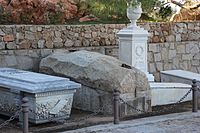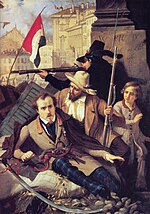Giuseppe Garibaldi
This articleneeds additional citations forverification.(April 2024) |
Giuseppe Garibaldi | |
|---|---|
 Garibaldi in 1866 | |
| |
| In office 18 February 1861 – 2 June 1882 | |
| Dictator of Sicily | |
| In office 17 May 1860 – 4 November 1860 | |
| Minister of War of theRoman Republic | |
| In office 9 February 1849 – 25 April 1849 | |
| Preceded by | Position established |
| Succeeded by | Position abolished |
| Personal details | |
| Born | Joseph-Marie Garibaldi 4 July 1807 Nice,First French Empire |
| Died | 2 June 1882(aged 74) Caprera,Kingdom of Italy |
| Nationality | Italian |
| Political party |
|
| Spouses | Giuseppina Raimondi
(m.1860;sep.1860)Francesca Armosino (m.1880) |
| Children | 8, includingMenottiandRicciotti |
| Signature | |
| Military service | |
| Allegiance | |
| Branch | |
| Service years | 1835–1871 |
| Rank | General |
| Commands | |
| Wars | Ragamuffin War
|
| Part of thePolitics series |
| Republicanism |
|---|
|
|
Giuseppe Maria Garibaldi(/ˌɡærɪˈbɑːldi/GARR-ib-AHL-dee,Italian:[dʒuˈzɛppeɡariˈbaldi];[note 1]4 July 1807 – 2 June 1882) was an Italian general, patriot,revolutionaryand republican. He contributed toItalian unification(Risorgimento) and thecreation of the Kingdom of Italy.He is considered to be one of Italy's "fathers of the fatherland",along withCamillo Benso, Count of Cavour,Victor Emmanuel II of ItalyandGiuseppe Mazzini.[1]Garibaldi is also known as the "Hero of the Two Worlds" because of his military enterprises in South America and Europe.[2]
Garibaldi was a follower of theItalian nationalistMazzini and embraced therepublicannationalism of theYoung Italymovement.[3]He became a supporter of Italian unification under ademocratic republicangovernment. However, breaking with Mazzini, he pragmatically allied himself with the monarchist Cavour andKingdom of Sardiniain the struggle for independence, subordinating his republican ideals to his nationalist ones until Italy was unified. After participating in an uprising in Piedmont, he was sentenced to death, but escaped and sailed to South America, where he spent 14 years in exile, during which he took part in several wars and learned the art of guerrilla warfare.[4]In 1835 he joined the rebels known as the Ragamuffins (farrapos), in theRagamuffin Warin Brazil, and took up their cause of establishing theRiograndense Republicand later theCatarinense Republic.Garibaldi also became involved in theUruguayan Civil War,raising an Italian force known asRedshirts,and is still celebrated as an important contributor to Uruguay's reconstitution.
In 1848, Garibaldi returned to Italy and commanded and fought in military campaigns that eventually led to Italian unification. The provisional government ofMilanmade him a general and theMinister of Warpromoted him to General of theRoman Republicin 1849. When thewar of independencebroke out in April 1859, he led hisHunters of the Alpsin the capture of major cities in Lombardy, includingVareseandComo,and reached the frontier of South Tyrol; the war ended with the acquisition of Lombardy. The following year, 1860, he led theExpedition of the Thousandon behalf of, and with the consent of, Victor Emmanuel II, King of Sardinia. The expedition was a success and concluded with the annexation of Sicily, Southern Italy, Marche and Umbria to theKingdom of Sardiniabefore the creation of a unified Kingdom of Italy on 17 March 1861. His last military campaign took place during theFranco-Prussian Waras commander of theArmy of the Vosges.
Garibaldi became an international figurehead for national independence and republican ideals, and is considered by twentieth-century historiography and popular culture as Italy's greatestnational hero.[5][6]He was showered with admiration and praise by many contemporary intellectuals and political figures, includingAbraham Lincoln,[7]William Brown,[8]Francesco de Sanctis,Victor Hugo,Alexandre Dumas,Malwida von Meysenbug,George Sand,Charles Dickens,[9]andFriedrich Engels.[10]
Garibaldi also inspired later figures likeJawaharlal NehruandChe Guevara.[11]HistorianA. J. P. Taylorcalled him "the only wholly admirable figure in modern history".[12]In the popular telling of his story, he is associated with thered shirtsthat his volunteers, theGaribaldini,wore in lieu of a uniform.
Early life
[edit]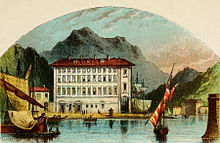
Garibaldi was born and christened Joseph-Marie Garibaldi[13][note 2]on 4 July 1807 inNice,which had been conquered by theFrench Republicin 1792, to theLigurianfamily of Domenico Garibaldi fromChiavari[14]and Maria Rosa Nicoletta Raimondi fromLoano.[15]In 1814, theCongress of Viennareturned Nice toVictor Emmanuel I of Sardinia.(Nice would be returned to France in 1860 by theTreaty of Turin,over the objections of Garibaldi.)
Garibaldi's family's involvement in coastal trade drew him to a life at sea.
He lived in thePeradistrict ofConstantinoplefrom 1828 to 1832. He became an instructor and taughtItalian,French,andmathematics.[16]
In April 1833, he travelled toTaganrog,in theRussian Empire,aboard theschoonerClorindawith a shipment oforanges.During ten days in port, he met Giovanni Battista Cuneo fromOneglia,a politically active immigrant and member of the secretYoung Italymovement ofGiuseppe Mazzini.Mazzini was a passionate proponent of Italian unification as a liberal republic via political and social reform.
In November 1833, Garibaldi met Mazzini inGenoa,starting a long relationship that later became troubled. He joined theCarbonarirevolutionary association, and in February 1834 participated in a failed Mazzinian insurrection inPiedmont.
South America
[edit]
Garibaldi first sailed to theBeylik of Tunisbefore eventually finding his way to theEmpire of Brazil.Once there, he took up the cause of theRiograndense Republicin its attempt to separate from Brazil, joining the rebels known as the Ragamuffins in theRagamuffin Warof 1835.
During this war, he metAna Maria de Jesus Ribeiro da Silva,commonly known as Anita. When the rebels proclaimed theCatarinense Republicin the Brazilian province ofSanta Catarinain 1839, she joined him aboard his ship,Rio Pardo,and fought alongside him at the battles of Imbituba and Laguna.
In 1841, Garibaldi and Anita moved toMontevideo,Uruguay,where Garibaldi worked as a trader and schoolmaster. The couple married inChurch of St. Francis of Assisiin theCiudad Viejaneighborhood, the following year.[17]They had four children;Domenico Menotti(1840–1903), Rosa (1843–1845), Teresa Teresita (1845–1903), andRicciotti(1847–1924).[18]A skilled horsewoman, Anita is said[by whom?]to have taught Giuseppe about thegauchoculture ofArgentina,southern Brazil and Uruguay. Around this time he adopted his trademark clothing—the red shirt,poncho,and hat commonly worn by gauchos.
In 1842, Garibaldi took command of theUruguayan fleetand raised an Italian Legion of soldiers—known asRedshirts—for theUruguayan Civil War.This recruitment was possible as Montevideo had a large Italian population at the time: 4,205 out of a total population of 30,000 according to an 1843 census.[19]

Garibaldi aligned his forces with the UruguayanColoradosled byFructuoso RiveraandJoaquín Suárez,who were aligned with the ArgentineUnitarian Party.This faction received some support from the French and British in their struggle against the forces of former Uruguayan presidentManuel Oribe'sBlancos,which was also aligned with ArgentineFederalesunder the rule ofBuenos AirescaudilloJuan Manuel de Rosas.The Italian Legion adopted a black flag that represented Italy in mourning, with a volcano at the centre that symbolized the dormant power in their homeland. Though contemporary sources do not mention the Redshirts, popular history asserts that the legion first wore them in Uruguay, getting them from a factory in Montevideo that had intended to export them to the slaughterhouses of Argentina. These shirts became the symbol of Garibaldi and his followers.[20]
Between 1842 and 1848, Garibaldidefended Montevideoagainst forces led by Oribe. In 1845, he managed to occupyColonia del SacramentoandMartín García Island,and led the infamous sacks of Martín García island andGualeguaychúduring theAnglo-French blockade of the Río de la Plata.Garibaldi escaped with his life after being defeated in theCosta Brava combat,delivered on 15 and 16 August 1842, thanks to the mercy of AdmiralWilliam Brown.The Argentines, wanting to pursue him to finish him off, were stopped by Brown who exclaimed "let him escape, that gringo is a brave man."[21]Years later, a grandson of Garibaldi would be named William, in honour of Admiral Brown. Adopting amphibious[19]guerrilla tactics, Garibaldi later achieved two victories during 1846, in the Battle of Cerro and the Battle of San Antonio del Santo.
Induction to Freemasonry
[edit]Garibaldi joinedFreemasonryduring his exile, taking advantage of the asylum the lodges offered to political refugees from European countries. At the age of 37, during 1844, Garibaldi was initiated in the L' Asil de la Vertud Lodge of Montevideo. This was an irregular lodge under a Brazilian Freemasonry not recognized by the main international masonic obediences, such as theUnited Grand Lodge of Englandor theGrand Orient de France.
While Garibaldi had little use for Masonic rituals, he was an active Freemason and regarded Freemasonry as a network that united progressive men as brothers both within nations and as a global community. Garibaldi was eventually elected as theGrand Masterof theGrand Orient of Italy.[22][23]
Garibaldi regularized his position later in 1844, joining the lodge Les Amis de la Patrie ofMontevideounder the Grand Orient of France.
Election of Pope Pius IX, 1846
[edit]The fate of his homeland continued to concern Garibaldi. The election ofPope Pius IXin 1846 caused a sensation among Italian patriots, both at home and in exile. Pius's initial reforms seemed to identify him as the liberal pope called for byVincenzo Gioberti,who went on to lead the unification of Italy. When news of these reforms reached Montevideo, Garibaldi wrote to the Pope:
If these hands, used to fighting, would be acceptable to His Holiness, we most thankfully dedicate them to the service of him who deserves so well of the Church and of the fatherland. Joyful indeed shall we and our companions in whose name we speak be, if we may be allowed to shed our blood in defence of Pius IX's work of redemption.[24]
Mazzini, from exile, also applauded the early reforms of Pius IX. In 1847, Garibaldi offered theapostolic nuncioatRio de Janeiro,Bedini, the service of his Italian Legion for the liberation of the peninsula. Then news of the outbreak of theSicilian revolution of 1848in January and revolutionary agitation elsewhere in Italy, encouraged Garibaldi to lead approximately 60 members of his legion home.
Return to Italy
[edit]First Italian War of Independence
[edit]
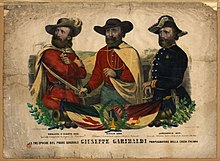
Garibaldi returned to Italy amidst the turmoil of therevolutions of 1848 in the Italian statesand was one of the founders and leaders of theAction Party.Garibaldi offered his services toCharles Albert of Sardinia,who displayed some liberal inclinations, but he treated Garibaldi with coolness and distrust. Rebuffed by the Piedmontese, he and his followers crossed intoLombardywhere they offered assistance to the provisional government ofMilan,which had rebelled against the Austrian occupation. In the course of the following unsuccessfulFirst Italian War of Independence,Garibaldi led his legion to two minor victories atLuinoandMorazzone.
After the crushing Piedmontese defeat at theBattle of Novaraon 23 March 1849, Garibaldi moved toRometo support theRoman Republicrecently proclaimed in thePapal States.However, a French force sent byLouis Napoleonthreatened to topple it. At Mazzini's urging, Garibaldi took command of the defence of Rome. In fighting nearVelletri,Achille Cantonisaved his life. After Cantoni's death, during theBattle of Mentana,Garibaldi wrote the novelCantoni the Volunteer.

On 30 April 1849, the Republican army, under Garibaldi's command, defeated a numerically far superior French army at thePorta San Pancraziogate of Rome. Subsequently, French reinforcements arrived, and theSiege of Romebegan on 1 June. Despite the resistance of the Republican army, the French prevailed on 29 June. On 30 June the Roman Assembly met and debated three options: surrender, continue fighting in the streets, or retreat from Rome to continue resistance from theApennine mountains.Garibaldi, having entered the chamber covered in blood, made a speech favouring the third option, ending with:Ovunque noi saremo, sarà Roma[25]( "Wherever we will go, that will be Rome" ).
The sides negotiated a truce on 1–2 July, Garibaldi withdrew from Rome with 4,000 troops, and ceded his ambition to rouse popular rebellion against the Austrians in central Italy. The French Army entered Rome on 3 July and reestablished theHoly See's temporal power. Garibaldi and his forces, hunted by Austrian, French, Spanish, and Neapolitan troops, fled to the north, intending to reachVenice,where theVenetians were still resistingthe Austrian siege.[26]After an epic march, Garibaldi took temporary refuge inSan Marino,with only 250 men having not abandoned him. Anita, who was carrying their fifth child, died nearComacchioduring the retreat.
North America and the Pacific
[edit]Garibaldi eventually managed to reachPorto Venere,nearLa Spezia,but the Piedmontese government forced him to emigrate again. He went toTangier,where he stayed withFrancesco Carpanetto,a wealthy Italian merchant. Carpanetto suggested that he and some of his associates finance the purchase of a merchant ship, which Garibaldi would command. Garibaldi agreed, feeling that his political goals were, for the moment, unreachable, and he could at least earn a living.[27]

The ship was to be purchased in theUnited States.Garibaldi went toNew York City,arriving on 30 July 1850. However, the funds for buying a ship were lacking. While in New York, he stayed with various Italian friends, including some exiled revolutionaries. He attended the Masonic lodges of New York in 1850, where he met several supporters of democratic internationalism, whose minds were open to socialist thought, and to giving Freemasonry a strong anti-papal stance.[23]
The inventorAntonio Meucciemployed Garibaldi in his candle factory onStaten Island[28](the cottage where he stayed is listed on the U.S.National Register of Historic Placesand is preserved as theGaribaldi Memorial). Garibaldi was not satisfied with this, and in April 1851 he left New York with his friend Carpanetto forCentral America,where Carpanetto was establishing business operations. They first went toNicaragua,and then to other parts of the region. Garibaldi accompanied Carpanetto as a companion, not a business partner, and used the nameGiuseppe Pane.[27]
Carpanetto went on toLima,Peru,where a shipload of his goods was due, arriving late in 1851 with Garibaldi. En route, Garibaldi called on revolutionary heroineManuela Sáenz.At Lima, Garibaldi was generally welcomed. A local Italian merchant, Pietro Denegri, gave him command of his shipCarmenfor a trading voyage across thePacific,for which he required Peruvian citizenship, which he obtained that year.[29]Garibaldi took theCarmento theChincha Islandsfor a load ofguano.Then on 10 January 1852, he sailed from Peru forCanton,China,arriving in April.[27]
After side trips toXiamenandManila,Garibaldi brought theCarmenback to Peru via theIndian Oceanand theSouth Pacific,passing clear around the south coast ofAustralia.He visitedThree Hummock Islandin theBass Strait.[27]Garibaldi then took theCarmenon a second voyage: to the United States viaCape Hornwith copper fromChile,and also wool. Garibaldi arrived inBostonand went on to New York. There he received a hostile letter from Denegri and resigned his command.[27]Another Italian, Captain Figari, had just come to the U.S. to buy a ship and hired Garibaldi to take the ship to Europe. Figari and Garibaldi bought theCommonwealthinBaltimore,and Garibaldi left New York for the last time in November 1853.[28]He sailed theCommonwealthtoLondon,and then toNewcastle upon Tynefor coal.[27]
Tyneside
[edit]TheCommonwealtharrived on 21 March 1854. Garibaldi, already a popular figure onTyneside,was welcomed enthusiastically by local working men — although theNewcastle Courantreported that he refused an invitation to dine with dignitaries in the city. He stayed in Huntingdon PlaceTynemouthfor a few days,[30]and inSouth Shieldson Tyneside for over a month, departing at the end of April 1854. During his stay, he was presented with an inscribed sword, which his grandsonGiuseppe Garibaldi IIlater carried as a volunteer in British service in theSecond Boer War.[31]He then sailed toGenoa,where his five years of exile ended on 10 May 1854.[27]
Second Italian War of Independence
[edit]Garibaldi returned to Italy in 1854. Using an inheritance from the death of his brother, he bought half of the Italian island ofCaprera(north ofSardinia), devoting himself to agriculture. In 1859, theSecond Italian War of Independence(also known as the Franco-Austrian War) broke out in the midst of internal plots at the Sardinian government. Garibaldi was appointedmajor generaland formed a volunteer unit named theHunters of the Alps(Cacciatori delle Alpi). Thenceforth, Garibaldi abandoned Mazzini's republican ideal of the liberation of Italy, assuming that only the Sardinian monarchy could effectively achieve it. He and his volunteers won victories over the Austrians atVarese,Como,and other places.[32]
Garibaldi was very displeased as his home city of Nice (Nizzain Italian) had been surrendered to the French in return for crucial military assistance. In April 1860, as deputy for Nice in the Piedmontese parliament atTurin,he vehemently attackedCamillo Benso, Count of Cavour,for ceding theCounty of Nice(Nizzardo) to EmperorNapoleon IIIof France. In the following years, Garibaldi (with other passionateNizzardo Italians) promoted theItalian irredentismof his native city, supporting theNiçard Vespersriots in 1871.[33]
Campaign of 1860
[edit]
On 24 January 1860, Garibaldi married 18-year-old Giuseppina Raimondi. Immediately after the wedding ceremony, she informed him that she was pregnant with another man's child and Garibaldi left her the same day.[34]At the beginning of April 1860, uprisings inMessinaandPalermoin theKingdom of the Two Siciliesprovided Garibaldi with an opportunity. He gathered a group of volunteers calledi Mille(the Thousand), or theRedshirtsas popularly known, in two ships namedIl PiemonteandIl Lombardo,and left fromQuarto,inGenoa,on 5 May in the evening and landed atMarsala,on the westernmost point ofSicily,on 11 May.
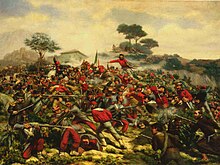
Swelling the ranks of his army with scattered bands of local rebels, Garibaldi led 800 volunteers to victory over an enemy force of 1,500 at theBattle of Calatafimion 15 May. He used the counter-intuitive tactic of an uphill bayonet charge. He saw that the hill was terraced, and the terraces would shelter his advancing men. Though small by comparison with the coming clashes at Palermo, Milazzo, and Volturno, this battle was decisive in establishing Garibaldi's power on the island. An apocryphal but realistic story had him say to his lieutenantNino Bixio,"Here we either make Italy, or we die."[35]: 253 His Neapolitan adversaries now fought for him, which led to accusations of bribery being made against their leader,Francesco Landi.[36]

The next day, he declared himselfdictator of Sicilyin the name ofVictor Emmanuel II of Italy.He advanced to the outskirts of Palermo, the capital of the island, andlaunched a siegeon 27 May. He had the support of many inhabitants, who rose up against the garrison, but before they could take the city, reinforcements arrived and bombarded the city nearly to ruins. At this time, a British admiral intervened and facilitated a truce, by which theNeapolitanroyal troops and warships surrendered the city and departed. The youngHenry Adams—later to become a distinguished American writer—visited the city in June and described the situation, along with his meeting with Garibaldi, in a long and vivid letter to his older brother Charles.[37]Historians Clough et al. argue that Garibaldi's Thousand were students, independent artisans, and professionals, not peasants. The support given by Sicilian peasants was not out of a sense of patriotism but from their hatred of exploitive landlords and oppressive Neapolitan officials. Garibaldi himself had no interest in social revolution and instead sided with the Sicilian landlords against the rioting peasants.[38]

By conquering Palermo, Garibaldi had won a signal victory. He gained worldwide renown and the adulation of Italians. Faith in his prowess was so strong that doubt, confusion, and dismay seized even the Neapolitan court. Six weeks later, he marched against Messina in the east of the island, winning a ferocious and difficultBattle of Milazzo.By the end of July, only the citadel resisted.[39]
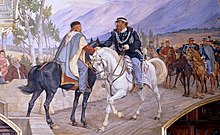
Having conquered Sicily, he crossed theStrait of Messinaand marched north.[40]Garibaldi's progress was met with more celebration than resistance, and on 7 September he entered the capital city ofNaples,by train. Despite taking Naples, however, he had not to this point defeated the Neapolitan army. Garibaldi's volunteer army of 24,000 was not able to conclusively defeat the reorganized Neapolitan army—about 25,000 men—on 30 September at theBattle of Volturno.This was the largest battle he ever fought, but its outcome was effectively decided by the arrival of theRoyal Sardinian Army.[41]
Meanwhile, Garibaldi's victories started to cause disquiet to the Piedmont, and particularly the Sardinian Prime Minister,Camillo Benso, Count of Cavour.He feared that, should the revolutionaries succeed in conquering the entire Neapolitan state, they would then invade the Papal States, which would lead to France intervening.[42]The Piedmontese themselves had conquered most of the Pope's territories in their march south to meet Garibaldi, but they had deliberately avoided Rome, the capital of the Papal state.[43]Garibaldi deeply disliked Cavour. To an extent, he simply mistrusted Cavour's pragmatism andrealpolitik,but he also bore a personal grudge for Cavour's trading away his home city of Nice to the French the previous year.[44]On the other hand, he supported the Sardinian monarch, Victor Emmanuel II, despite his dislike of royalty, who he admired as a champion of Italian independence.[45]In his famous meeting with Victor Emmanuel atTeanoon 26 October 1860, Garibaldi greeted him asKing of Italyand shook his hand. Garibaldi rode into Naples at the king's side on 7 November, then retired to the rocky island ofCaprera,refusing to accept any reward for his services.[46]
Aftermath
[edit]
At the outbreak of theAmerican Civil War(in 1861), Garibaldi was a very popular figure. The39th New York Volunteer Infantry Regimentwas namedGaribaldi Guardafter him.[47]Garibaldi expressed interest in aiding theUnion,and he was offered a major general's commission in the U.S. Army through a letter fromSecretary of StateWilliam H. SewardtoHenry Shelton Sanford,the U.S. Minister at Brussels, 27 July 1861.[7]On 9 September 1861, Sanford met with Garibaldi and reported the result of the meeting to Seward:
He said that the only way in which he could render service, as he ardently desired to do, to the cause of the United States, was as Commander-in-chief of its forces, that he would only go as such, and with the additional contingent power—to be governed by events—of declaring the abolition of slavery—that he would be of little use without the first, and without the second it would appear like a civil war in which the world at large could have little interest or sympathy.[48]
ButAbraham Lincolnwas not ready to free the slaves; Sanford's meeting with Garibaldi occurred a year before Lincoln issued the preliminaryEmancipation Proclamation.Sanford's mission was hopeless, and Garibaldi did not join the Union army.[49]A historian of the American Civil War,Don H. Doyle,however, wrote, "Garibaldi's full-throated endorsement of the Union cause roused popular support just as news of the Emancipation Proclamation broke in Europe."[50]On 6 August 1863, after Lincoln had issued the final Emancipation Proclamation, Garibaldi wrote to Lincoln, "Posterity will call you the great emancipator, a more enviable title than any crown could be, and greater than any merely mundane treasure."[51]
On 5 October 1860, Garibaldi set up theInternational Legionbringing together different national divisions of French, Poles, Swiss, Germans and other nationalities, with a view not just of finishing the liberation of Italy, but also of their homelands. With the motto "Free from theAlpsto theAdriatic",[52]the unification movement set its gaze on Rome and Venice. Mazzini was discontented with the perpetuation of monarchial government, and continued to agitate for a republic. Garibaldi, frustrated at inaction by the king, and bristling over perceived snubs, organized a new venture. This time, he intended to take on thePapal States.
Expedition against Rome
[edit]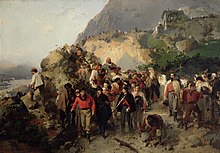
Garibaldi himself was intenselyanti-Catholicand anti-papal. His efforts to overthrow the pope by military action mobilized anti-Catholic support. On 28 September 1862, 500 Irish labourers disrupted a pro-Garibaldi meeting in London by chanting "God and Rome", which triggered weeks of ethnic conflict between Protestants and Irish Catholics.[53]Garibaldi's hostility to the pope's temporal domain was viewed with great distrust by Catholics around the world, and the French EmperorNapoleon IIIhad guaranteed the independence of Rome from Italy by stationing a French garrison there. Victor Emmanuel was wary of the international repercussions of attacking Rome and the pope's seat there, and discouraged his subjects from participating in revolutionary ventures with such intentions. Nonetheless, Garibaldi believed he had the secret support of his government. Once he was excommunicated by the pope, he chose the Protestant pastorAlessandro Gavazzias his army chaplain.[54]
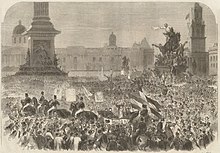
In June 1862, he sailed from Genoa to Palermo to gather volunteers for the impending campaign, under the sloganRoma o Morte( "Rome or Death" ). An enthusiastic party quickly joined him, and he turned for Messina, hoping to cross to the mainland there. He arrived with a force of around two thousand, but the garrison proved loyal to the king's instructions and barred his passage. They turned south and set sail fromCatania,where Garibaldi declared that he would enter Rome as a victor or perish beneath its walls. He landed atMelito di Porto Salvoon 14 August and marched at once into theCalabrianmountains.

Far from supporting this endeavour, the Italian government was quite disapproving. GeneralEnrico Cialdinidispatched a division of the regular army, under Colonel Emilio Pallavicini, against the volunteer bands. On 28 August, thetwo forces metin the ruggedAspromonte.One of the regulars fired a chance shot, and several volleys followed, killing a few of the volunteers. The fighting ended quickly, as Garibaldi forbade his men to return fire on fellow subjects of theKingdom of Italy.Many of the volunteers were taken prisoner, including Garibaldi, who had been wounded by a shot in the foot. The episode was the origin of a famous Italiannursery rhyme:Garibaldi fu ferito( "Garibaldi was wounded" ).
A government steamer took him to a prison atVarignanonearLa Spezia,where he was held in a sort of honourable imprisonment and underwent a tedious and painful operation to heal his wound. His venture had failed, but he was consoled by Europe's sympathy and continued interest. After he regained his health, the government released Garibaldi and let him return to Caprera.
En route toLondonin 1864 he stopped briefly inMalta,where many admirers visited him in his hotel.[55]Protests by opponents of his anticlericalism were suppressed by the authorities. In London, his presence was received with enthusiasm by the population.[56]He met the British Prime MinisterViscount Palmerston,as well as revolutionaries then living in exile in the city. At that time, his ambitious international project included the liberation of a range of occupied nations, such asCroatia,Greece,andHungary.He also visitedBedfordand was given a tour of the Britannia Iron Works, where he planted a tree (which was cut down in 1944 due to decay).[57]
Final struggle with Austria
[edit]
Garibaldi took up arms again in 1866, this time with the full support of the Italian government. TheAustro-Prussian Warhad broken out, and Italy had allied withPrussiaagainst theAustrian Empirein the hope of takingVenetiafrom Austrian rule in theThird Italian War of Independence.Garibaldi gathered again his Hunters of the Alps, now some 40,000 strong, andled theminto theTrentino.He defeated the Austrians atBezzecca,and made forTrento.
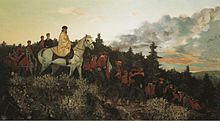
The Italian regular forces were defeated atLissaon the sea, and made little progress on land after the disaster ofCustoza.The sides signed an armistice by which Austria ceded Venetia to Italy, but this result was largely due to Prussia's successes on the northern front. Garibaldi's advance through Trentino was for nought, and he was ordered to stop his advance to Trento. Garibaldi answered with a short telegram from the main square of Bezzecca with the famous motto:Obbedisco!( "I obey!" ).[58]
After the war, Garibaldi led a political party that agitated for the capture of Rome, the peninsula's ancient capital. In 1867, he again marched on the city, but the Papal army, supported by a French auxiliary force, proved a match for his badly armed volunteers. He was shot in the leg in theBattle of Mentana,and had to withdraw from the Papal territory. The Italian government again imprisoned him for some time, after which he returned to Caprera.
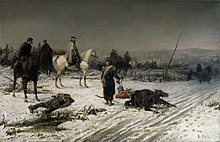
In the same year, Garibaldi sought international support for altogether eliminating the papacy. At the 1867 congress for theLeague of Peace and FreedominGenevahe proposed: "The papacy, being the most harmful of all secret societies, ought to be abolished."[59]
Franco-Prussian War
[edit]When theFranco-Prussian Warbroke out in July 1870, Italian public opinion heavily favoured the Prussians, and many Italians attempted to sign up as volunteers at the Prussian embassy in Florence. After the French garrison was recalled from Rome, the Italian Armycaptured the Papal Stateswithout Garibaldi's assistance. Following the wartime collapse of theSecond French Empireafter theBattle of Sedan,Garibaldi, undaunted by the recent hostility shown to him by the men of Napoleon III, switched his support to the newly declaredGovernment of National Defenseof France. On 7 September 1870, within three days of the revolution in Paris that ended the Empire, he wrote to theMovimentoof Genoa, "Yesterday I said to you: war to the death to Bonaparte. Today I say to you: rescue the French Republic by every means."[60]
Subsequently, Garibaldi went to France and assumed command of theArmy of the Vosges,an army of volunteers. French socialistLouis Blancreferred to Garibaldi as a "soldier of revolutionary cosmopolitanism" based on his support for liberation movements throughout the world.[61]After the war he waselectedto the FrenchNational Assembly,where he briefly served as a member of Parliament forAlpes-Maritimesbefore returning to Caprera.[62][63]
Involvement with the First International
[edit]When theParis Communeerupted in 1871, Garibaldi joined with younger radicals such asFelice Cavallottiin declaring his full support for theCommunardsandinternationalism.[64]Garibaldi suggested a grand alliance between various factions of the left: "Why don't we pull together in one organized group the Freemasonry, democratic societies, workers' clubs, Rationalists, Mutual Aid, etc., which have the same tendency towards good?".[64]He began organizing a Congress of Unity, which was supported by many of the radical, free-thinking, and socialist groups throughout Italy such asLa Plebe.[64]The Congress was held in theTeatro Argentinadespite being banned by the government, and endorsed a set of radical policies including universal suffrage, progressive taxation, compulsory lay education, administrative reform, and abolition of the death penalty.[64]
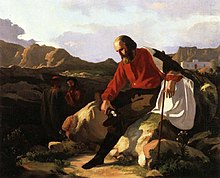
Garibaldi had long claimed an interest in vague ethical socialism such as that advanced byHenri Saint-Simonand saw the struggle for liberty as an international affair, one which "does not make any distinction between the African and the American, the European and the Asian, and therefore proclaims the fraternity of all men whatever nation they belong to".[61][65]He interpreted theInternational Workingmen's Associationas an extension of the humanitarian ideals for which he had always fought. Although he did not agree with their calls for the abolition of property, Garibaldi defended the Communards and theFirst Internationalagainst the attacks of their enemies: "Is it not the product of the abnormal state in which society finds itself in the world? [...] Shouldn't a society (I mean a human society) in which the majority struggle for subsistence and the minority want to take the larger part of the product of the former through deceptions and violence but without hard work, arouse discontent and thoughts of revenge amongst those who suffer?".[61]
Garibaldi wrote a letter toCelso Cerettiin which he declared: "The International is the sun of the future [sole dell'avvenire]! ".[61][66]The letter was printed in dozens of workers' news sheets and papers, and was instrumental in persuading many fence-sitters to join the organization.[66]After Garibaldi's death, many of his disciples embraced thelibertarian socialistideas ofMikhail Bakunin.[67]As Italy still lacked an industrial proletariat, "Garibaldi's socialism represented most accurately craft trade-unionism and a general focus on economic egalitarianism".[68]His socialism was a "socialism wherein the struggle against every injustice, and a love for freedom, predominated. Garibaldi was not an unpractical man, but an active witness of that kind of generosity in feelings and firm wish for justice".[69]In the first volume of Carl Landauer'sEuropean Socialism,Garibaldi is mentioned alongside Mazzini as outstanding "Italian revolutionaries".[70]
According toDenis Mack Smith,"the difference is not so large when we find what Garibaldi meant by the term. Socialism for him was nothing very revolutionary, and perhaps he flaunted the word partly because he delighted to feel that it would shock the Mazzinians."[71]In describing the move to the left of Garibaldi and the Mazzinians,Lucy Riallwrites that this "emphasis by younger radicals on the 'social question' was paralleled by an increase in what was called 'internationalist' or socialist activity (mostly Bakuninist anarchism) throughout northern and southern Italy, which was given a big boost by the Paris Commune". The rise of this socialism "represented a genuine challenge to Mazzini and the Mazzinian emphasis on politics and culture; and Mazzinis' death early in 1872 only served to underline the prevailing sense that his political era was over. Garibaldi now broke definitively with Mazzini, and this time he moved to the left of him. He came out entirely in favour of the Paris Commune and internationalism, and his stance brought him much closer to the younger radicals, especiallyFelice Cavallotti,and gave him a new lease on political life. From his support was born an initiative to relaunch a broad party of the radical left. "[64]
Despite being elected again to the Italian parliament, first as part of theHistorical Leftand then of theHistorical Far Left,Garibaldi spent much of his late years onCaprera.[18]However, he still managed to serve the Italian parliament with extreme distinction and supported an ambitious project of land reclamation in the marshy areas of southernLazio.In 1879, Garibaldi founded the League of Democracy, along with Cavallotti,Alberto MarioandAgostino Bertani,which reiterated his support for universal suffrage, abolition of ecclesiastical property, the legal and politicalemancipation of womenand a plan of public works to improve the Roman countryside that was completed.[64]
On the Ottoman Empire
[edit]In a 6 October 1875 letter from Caprera, "To my brothers of theHerzegovinaand to the oppressed of Eastern Europe ", Garibaldi wrote:
TheTurkmust go away toBroussa.He descended like a wolf, passing theBosphorus,devastating, murdering, and violating those populations who gave us thePelasgi,who were, perhaps, the first civilisers of Europe. He must no longer tread upon that part of the world kept by him in misery. At Broussa, with his vices, depredations, and cruelties, he will find enough people ofAsia Minorto torment and plunge into desolation. Rise, then, heroic sons ofMontenegro,Herzegovina,Bosnia,Servia,Therapia,Macedonia,Greece,Epirus,Albania,Bulgaria,andRoumania!All of you have a most splendid history. Among you were bornLeonidas,Achilles,Alexander,Scanderbeg,andSpartacus.And today even, among your robust populations, you may still find a Spartacus and a Leonidas. Do not trust to diplomacy. That old woman without a heart certainly deceives you. But with you are all the men of heart throughout the world.Englandherself, till today favourable to the Turks, has manifested to you by means of the obolus and sympathy of one of her great men that she ought to prefer the alliance and gratitude of a confederation of free peoples to the decrepit confederation ofThe Empire of the Crescent.Then to Broussa with the Turk! Only thus can you make yourself independent and free. On this side of the Bosphorus the fierce Ottoman will always be under the stimulant of eternal war, and you will never obtain the sacred rights of man.[72][73][74][75]
Death
[edit]Ill and confined to bed byarthritis,Garibaldi made trips toCalabriaand Sicily. In 1880, he married Francesca Armosino, with whom he previously had three children. Before the wedding, he stated he was not aCatholicand was willing to become aProtestant.[76][77]Though raised a Catholic he abjuredChristianitytowards the end of his life and became a deist and a supporter ofFreemasonry.On his deathbed, Garibaldi asked for his bed to be moved to where he could view the sea. On his death on 2 June 1882 at the age of almost 75, his wishes for a simple funeral and cremation were not respected. He was buried on his farm on the island ofCapreraalongside his last wife and some of his children.[78]
In 2012, Garibaldi's descendants announced that, with permission from authorities, they would have Garibaldi's remains exhumed to confirm through DNA analysis that the remains in the tomb are indeed Garibaldi's. Some anticipated that there would be a debate about whether to preserve the remains or to grant his final wish for a simple cremation.[79]In 2013, personnel changes at the Ministry of Culture sidelined the exhumation plans. The new authorities were "less than enthusiastic" about the plan.[80]
Legacy
[edit]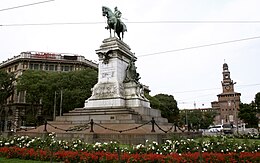
Garibaldi's popularity, skill at rousing the common people and his military exploits are all credited with making theunification of Italypossible. He also served as a global exemplar of mid-19th century revolutionaryliberalismandnationalism.After the liberation of southern Italy from theNeapolitan monarchyin theKingdom of the Two Sicilies,Garibaldi chose to sacrifice hisliberal republicanprinciples for the sake of unification.[81]Garibaldi's acclaim stretched across Europe with his name revered in Britain to America and France, the tale of an Italian vagabond trekking the South American plains from battle to battle with his pregnant wife in tow, and then returning home and for the love of his homeland forsaking his ambition of making Italy a republic. His exploits became legendary, and when he toured Britain in his older days he was received as a hero.[82]
Garibaldi subscribed to theanti-clericalismcommon among Latin liberals and did much to circumscribe the temporal power of thePapacy.His personal religious convictions are unclear to historians. In 1882, he wrote that "Man created God, not God created Man", yet he is quoted as saying in his autobiography: "I am a Christian, and I speak to Christians—I am a true Christian, and I speak to true Christians. I love and venerate the religion of Christ, because Christ came into the world to deliver humanity from slavery. [...] You have the duty to educate the people—educate the people—educate them to be Christians—educate them to be Italians. [...] Viva l'Italia! Viva Christianity!".[83]
 |
 |
Garibaldi was a popular hero in Britain. In his review of Lucy Riall's Garibaldi biography forThe New Yorker,Tim Parkscites the English historianA. J. P. Tayloras saying that "Garibaldi is the only wholly admirable figure in modern history".[12]British historianDenis Mack Smithwrote:
At the height of glory, Giuseppe Garibaldi was perhaps the most famous person in Italy. His name was much more famous than that ofCavourandMazzini,and many more people would have heard of him thanVerdiorManzoni.Abroad, Garibaldi symbolized theRisorgimentoItaly of those dramatic years and the intrepid audacity that contributed so much to the formation of the Italian nation. [...] A professional liberator, he fought for the oppressed people wherever he found them. Despite having the temperament of the fighter and the man of action, he managed to be an idealist distinctly distinct from his colder-minded contemporaries. Everything he did, he did it with passionate conviction and unlimited enthusiasm; a career full of color and unexpected shows us one of the most romantic products of the time. Moreover, he was a lovable and charming person, of transparent honesty, who was obeyed without hesitation and for whom he died happy.[84][85]
AboutG. M. Trevelyan's work on Garibaldi,David Cannadinewrote:
Trevelyan's great work was his Garibaldi trilogy (1907–11), which established his reputation as the outstanding literary historian of his generation. It depicted Garibaldi as aCarlyleanhero—poet, patriot, and man of action—whose inspired leadership created the Italian nation. For Trevelyan, Garibaldi was the champion of freedom, progress, and tolerance, who vanquished the despotism, reaction, and obscurantism of the Austrian empire and the Neapolitan monarchy. The books were also notable for their vivid evocation of landscape (Trevelyan had himself followed the course of Garibaldi's marches), for their innovative use of documentary and oral sources, and for their spirited accounts of battles and military campaigns.[86]

Along with Giuseppe Mazzini and other Europeans, Garibaldi supported the creation of a European federation. Many Europeans expected that the 1871unification of Germanywould make Germany a European and world leader that would champion humanitarian policies. This idea is apparent in the following letter Garibaldi sent toKarl Blindon 10 April 1865:
The progress of humanity seems to have come to a halt, and you with your superior intelligence will know why. The reason is that the world lacks a nation which possesses true leadership. Such leadership, of course, is required not to dominate other peoples, but to lead them along the path of duty, to lead them toward the brotherhood of nations where all the barriers erected by egoism will be destroyed. We need the kind of leadership which, in the true tradition of medievalchivalry,would devote itself to redressing wrongs, supporting the weak, sacrificing momentary gains and material advantage for the much finer and more satisfying achievement of relieving the suffering of our fellow men. We need a nation courageous enough to give us a lead in this direction. It would rally to its cause all those who are suffering wrong or who aspire to a better life, and all those who are now enduring foreign oppression. This role of world leadership, left vacant as things are today, might well be occupied by the German nation. You Germans, with your grave and philosophic character, might well be the ones who could win the confidence of others and guarantee the future stability of the international community. Let us hope, then, that you can use your energy to overcome your moth-eatenthirty tyrantsof the various German states. Let us hope that in the centre of Europe you can then make a unified nation out of your fifty million. All the rest of us would eagerly and joyfully follow you.[87]
Through the years, Garibaldi was showered with admiration and praises by many intellectuals and political figures.Francesco De Sanctisstated that "Garibaldi must win by force: he is not a man; he is a symbol, a form; he is the Italian soul. Between the beats of his heart, everyone hears the beats of his own."[88]AdmiralWilliam Browncalled him "the most generous of the pirates I have ever encountered".[8]Argentine revolutionaryChe Guevarastated: "The only hero the world has ever needed is called Giuseppe Garibaldi."[11]
Commemoration
[edit]
Five ships of theItalian Navyhave been named after him, including a World War IIcruiserand the formerflagship,theaircraft carrierGiuseppe Garibaldi.Statues of his likeness, as well as the handshake of Teano, stand in many Italian squares, and in other countries around the world. On the top of theJaniculumhill in Rome, there is a statue of Garibaldi on horseback. Many theatres in Sicily take their name from him and are named Garibaldi Theatre.
Several worldwide military units are named after Garibaldi, including the PolishGaribaldi Legionduring theJanuary Uprisingand the French foreignGaribaldi Legionduring World War I. The39th New York Volunteer Infantry Regimentof theAmerican Civil Warwas namedGaribaldi Guardafter him.[47]Also, a bust of Giuseppe Garibaldi is prominently placed outside the entrance to the old Supreme Court Chamber in theUnited States CapitolBuilding inWashington, DC,a gift from members of the Italian Society of Washington.
Greek Freemasons, in order to honour Garibaldi's struggles for freedom and in commemoration of the Redshirts' assistance during theGreco-Turkish War (1897),theBalkan Warsand theFirst World War,established a Lodge named after the great patriot in 1980. Lodge Giuseppe Garibaldi (no. 130) is still active and operates in Athens under the jurisdiction of theGrand Lodge of Greece.[89]
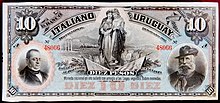
In 1865, the English football teamNottingham Forestchose their home colours from the uniform worn by Garibaldi and his men in 1865.[90]The Garibaldi SchoolinMansfield,Nottinghamshireis also named after him.[91]
TheGiuseppe Garibaldi Trophy(Italian:Trofeo Garibaldi;French:Trophée Garibaldi) is arugby uniontrophy awarded to the winner of the annualSix Nations Championshipmatch betweenFranceandItaly.[92]
TheGaribaldi biscuitwas named after him, as was a style of beard.[93]Garibaldiis also a name of a cocktail made of orange juice and Campari.
The Brazilian soccer clubAssociação Garibaldi de Esporteswas named after him.
A species of bright red-orange fish in the damselfish family received the vernacular nameGaribaldiin memory of the Garibaldi red shirts. Also, a species ofhoverfly,Sphiximorpha garibaldii,was described from a specimen collected in Italy shortly after Garibaldi's victory in theBattle of Varese,and named in his honour.[94]
Namesakes
[edit]Several places worldwide are named after him, including:
- Garibaldi, Victoria,Australia
- Garibaldi, Rio Grande do Sul,Brazil
- Garibaldi Square,Sofia,Bulgaria
- Giuseppe Garibaldi Park,Montreal,Canada
- Garibaldi, British Columbia,an abandoned settlement inBritish Columbia,Canada
- Mount Garibaldi,British Columbia, Canada
- Garibaldi Secondary School,British Columbia, Canada
- Garibaldi,a station online 13of theParis Métro,France
- Garibaldi, Oregon,United States
- The Garibaldi School,Nottinghamshire,United Kingdom
- The Garibaldi Hotel,Northampton,United Kingdom
- Giuseppe Garibaldi StreetandGaribaldi Bridge,Cluj-Napoca,Romania
Cultural depictions
[edit]Garibaldi is a major character in two juvenile historical novels byGeoffrey Trease:Follow My Black PlumeandA Thousand for Sicily.He also appears in the novelsHeartbyEdmondo De AmicisandFire on the MountainbyTerry Bisson.
In movies, Garibaldi is played byOsvaldo Valentiin the 1940 filmAntonio Meucci,byUgo Sassoin the 1950 filmCavalcade of Heroes,byRaf Vallonein the 1952 filmRed Shirts,byRenzo Ricciin the 1961 filmGaribaldi,and byGabriel Braga Nunesin the 2013 filmAnita e Garibaldi.He is also played byFranco Neroin the 1987 miniseriesIl generale,Thiago Lacerdain the 2003 Brazilian miniseriesA Casa das Sete Mulheresand byGiorgio Pasottiin the 2012 miniseriesAnita Garibaldi.
On 18 February 1960, the American television seriesDick Powell's Zane Grey Theatreaired the episode "Guns for Garibaldi" to commemorate the centennial of the unification of Italy. This was the only such program to emphasize the role of Italians in pre-Civil WarAmerica. The episode is set in Indian Creek, awesterngold mining town. Giulio Mandati, played byFernando Lamas,takes over his brother's gold claim. People in Indian Creek wanted to use the gold to finance a dam, but Mandati plans to lend support to General Garibaldi and Italian reunification. Garibaldi had asked for financing and volunteers from around the world as he launched his Redshirts in July 1860 to invade Sicily and conquer the Kingdom of Naples for annexation to what would finally become the newly born Kingdom of Italy with King Victor Emmanuel II.[95]
In theCapcomarcade gameKnights of the Round,the final boss character is named Garibaldi.
Family tree
[edit]This sectionis missing informationabout Garibaldi's second and third marriages.(May 2021) |
| Giuseppe Garibaldi | Ana Maria de Jesus Ribeiro da Silva | ||||||||||||||||||||||||||||||||||||||||||||||||||||||||||||||
| Domenico Menotti Garibaldi | Rosa "Rosita" Garibaldi | Teresa "Teresita" Garibaldi | Ricciotti Garibaldi | Harriet Constance Hopcraft | |||||||||||||||||||||||||||||||||||||||||||||||||||||||||||
| Peppino Garibaldi | Costante Garibaldi | Anita Italia Garibaldi | Ezio Garibaldi | Bruno Garibaldi | Ricciotti Garibaldi Jr. | Menotti Garibaldi Jr. | Sante Garibaldi | ||||||||||||||||||||||||||||||||||||||||||||||||||||||||
Publications
[edit]- Non-fiction
- Life.New York: Barnes. 1859.OCLC670372674.
- Autobiography.London: Smith & Innes. 1889.OCLC1069556440.
- My Life,translated by Stephen Parkin, foreword by Tim Parks. London: Hesperus Press Limited. 2004.ISBN1-84391-093-4
- Autobiography of Giuseppe Garibaldi Vol. I, II, III,translated by Alica Werner.New York: Howard Fertig. 1971.
- Fiction
- Cantoni il volontario.Milan: E. Politti. 1870.OCLC36348294.
- The rule of the monk.London:Cassell, Petter and Galpin.1870.OCLC780147202.
- I mille(in Italian). Turin: Camilla e Bertolero. 1874.OCLC1083429428.
See also
[edit]References
[edit]Footnotes
[edit]- ^In his nativeLigurian language,he is known asGioxeppe Gaibado(Ligurian:[dʒuˈʒɛpːeɡajˈbaːdu]). In his particularNiçard dialectof Ligurian, he was known asJousé([dʒuˈze]) orJosep([dʒuˈzɛp]).
- ^Pronounced inFrenchas[ʒozɛfmaʁiɡaʁibaldi].
Sources
[edit]- ^Bouchard, Norma (2005).Risorgimento in Modern Italian Culture: Revisiting the Nineteenth-Century Past in History, Narrative, and Cinema.Madison: Fairleigh Dickinson University Press. p. 76.ISBN978-0838640548.
- ^"Unità d'Italia: Giuseppe Garibaldi, l'eroe dei due mondi".Enciclopedia De Agostini.7 March 2011.Retrieved2 September2020– via Sapere.
- ^Riall, Lucy (2007).Garibaldi: Invention of a Hero.New Haven: Yale University Press. p. 1.ISBN978-0300144239.
- ^Ridley, Jaspar (2001).Phoenix: Garibaldi(illustrated, reprint ed.). London: Phoenix Press.ISBN9781842121528.
- ^AA.VV. (1999).La fabrique des héros.Maison des Sciences de l'Homme. p. 11.ISBN2-7351-0819-8.
- ^"La scuola per i 150 anni dell'Unità I protagonisti: Garibaldi".Archivedfrom the original on 27 October 2014.
- ^abMack Smith, ed., Denis (1969).Garibaldi(Great Lives Observed). Prentice Hall: Englewood Cliffs. pp. 69–70.ISBN978-0133467918.
- ^ab"Frasi di William Brown (ammiraglio)".LeCitazioni.Retrieved 2 September 2020. "È il più generoso dei pirati che abbia mai incontrato."
- ^Schlicke, Paul (2011).The Oxford Companion to Charles Dickens: Anniversary Edition.Oxford: Oxford University Press. p. 10.ISBN9780199640188.
- ^Rossi, Lauro (2010).Giuseppe Garibaldi due secoli di interpretazioni.Rome: Gangemi Editore. p. 238.ISBN978-8849292640.
- ^abDi Mino, Massimiliano; Di Mino, Pier Paolo (2011).Il libretto rosso di Garibaldi.Rome: Castelvecchi Editore. p. 7.ISBN978-8895903439.
- ^abParks, Tim (2 July 2007)."The Insurgent: Garibaldi and his enemies".The New Yorker.Retrieved2 September2020.
- ^Scirocco, Alfonso (2011).Garibaldi, battaglie, amori, ideali di un cittadino del mondo(in Italian). Bari: Laterza. p. 3.ISBN978-88-420-8408-2.
- ^Baptismal record: "Die 11 d.i (giugno 1766) Dominicus Antonina Filius Angeli Garibaldi q. Dom.ci et Margaritae Filiae q. Antonij Pucchj Coniugum natus die 9 huius et hodie baptizatus fuit a me Curato Levantibus Io. Bapta Pucchio q. Antonij, et Maria uxore Agostini Dassi. (Chiavari, Archive of the Parish Church of S. Giovanni Battista, Baptismal Record, vol. n. 10 (dal 1757 al 1774), p. 174).
- ^(often wrongly reported as Raimondi, but Status Animarum and Death Records all report the same name "Raimondo" ) Baptismal record from the Parish Church of S. Giovanni Battista in Loano: "1776, die vigesima octava Januarij. Ego Sebastianus Rocca praepositus hujus parrochialis Ecclesiae S[anct]i Joannis Baptistae praesentis loci Lodani, baptizavi infantem natam ex Josepho Raimimdi q. Bartholomei, de Cogoleto, incola Lodani, et [Maria] Magdalena Conti conjugibus, cui impositum est nomen Rosa Maria Nicolecta: patrini fuerunt D. Nicolaus Borro q. Benedicti de Petra et Angela Conti Joannis Baptistae de Alessio, incola Lodani." "Il trafugamento di Giuseppe Garibaldi dalla pineta di Ravenna a Modigliana ed in Liguria, 1849, di Giovanni Mini, Vicenza 1907 – Stab. Tip. L. Fabris.
- ^"Casa Garibaldi, Istanbul".14th Istanbul Biennial.Retrieved20 March2020.
- ^Arregui, Miguel."Un aventurero italiano en la Guerra Grande".El Observador.Retrieved24 March2024.
- ^abKleis, S. M. (2012). "Der Löwe von Caprera".Damals(in German). No. 6. pp. 57–59.
- ^abEtchechury Barrera, Mario (2017).""Defensores de la humanidad y la civilización". Las legiones extranjeras de Montevideo, entre el mito cosmopolita y la eclosión de las 'nacionalidades' (1838–1851) ".Historia(in Spanish).50(II): 491–524.
- ^Bourne, Richard (2020).Garibaldi in South America: An Exploration.Oxford: C. Hurst and Company (Publishers) Limited. p. 45.
- ^"Déjenlo que se escape".Historia Hoy. 15 August 2020.Retrieved19 July2022.
- ^Garibaldi – the masonTranslated from Giuseppe Garibaldi Massone by the Grand Orient of Italy
- ^ab"Garibaldi – freemason".freemasonry.bcy.ca.
- ^A. Werner,Autobiography of Giuseppe Garibaldi,Vol. III, Howard Fertig, New York (1971) p. 68.
- ^Hibbert, G. C (1965).Garibaldi and his enemies.London: Longmans. p. 94.
- ^"Garibaldi's Cabin".European Romanticisms in Association. 10 July 2020. Retrieved 14 September 2020.
- ^abcdefgGaribaldi, Giuseppe (1889).Autobiography of Giuseppe Garibaldi.Walter Smith and Innes. pp.54–69.
- ^abJackson, Kenneth T. (1995).The Encyclopedia of New York City.The New York Historical Society and Yale University Press. p.451.ISBN978-0300055368.
- ^Ferrero Costa, Augusto (2011).La presenza di Garibaldi in Perù(PDF).Universidad de Lima, Università degli Studi Roma Tre & Ministeri per i Beni e le Attività Culturali. p.40.ISBN978-9972452536.Archived fromthe original(PDF)on 6 March 2023.Retrieved16 January2023.
- ^"Giuseppe Garibaldi blue plaque".Open Plaques. Retrieved 14 September 2020. "Sailor / soldier Giuseppe Garibaldi 19th century Italian patriot stayed in this house in 1854 while visiting Tynemouth to brief local political and industrial leaders on his plans for a unified Italy. He was hailed throughout Europe as a true idealist and honest politician. He was born in Nice on 4th Feb 1807 and died aged 75 in Caprerra on 2nd June 1882."
- ^Bell, David.Ships, Strikes and Keelmen: Glimpses of North-Eastern Social History,2001ISBN1-901237-26-5
- ^Marwil, Jonathan (2010).Visiting Modern War in Risorgimento Italy.New York: Palgrave Macmillan. p. 47.ISBN978-0-23011-755-6.
- ^Courrière, Henri (2007). "Les troubles de février 1871 à Nice. Entre particularisme, séparatisme et République" [The troubles of February 1871 in Nice. Between particularism, separatism and Republic].Cahiers de la Méditerranée(in French) (74): 179–208.doi:10.4000/cdlm.2693.
- ^Hibbert, Christopher,Garibaldi and His Enemies.New York: Penguin Books, 1987, p. 171.
- ^Scirocco, Alfonso (2 September 2007).Garibaldi: Citizen of the World.Princeton University Press.ISBN978-0-691-11540-5.Retrieved2 February2022.
- ^Fentress, James (2018).Rebels and Mafiosi: Death in a Sicilian Landscape.Ithaca, NY: Cornell University Press. p. 100.ISBN978-1-50172-151-9.
- ^J.C. Levenson et al.,The Letters of Henry Adams, vol. 1: 1858–1868(1982) pp. 162–172.
- ^Shepard B. Cloughet al.,A History of the Western World(1964), p. 948.
- ^Schneid, 2012 pp. 63-64
- ^Smith 1939, p. 151
- ^Schneid, 2012 pp. 67-70
- ^Ridley, 2023 p.78
- ^Ridley, 2023 p.79
- ^Smith 1939, pp. 20, 39
- ^Godkin 1880, p. 184
- ^Godkin, 1880 p. 230
- ^abCivil War Home– The Civil War Society's "Encyclopedia of the Civil War" – Italian-Americans in the Civil War.
- ^Mack Smith, 1956 p. 70.
- ^The Union Makes an Offer to Garibaldi,The Lincoln Forum Bulletin,Issue 51, Spring 2022, p. 8.
- ^Don H. Doyle,The Cause of All Nations: An International History of the American Civil War(New York: Basic Books, 2015), 232.
- ^Mack Smith, 1956 p. 72.
- ^"Sangamo Journal / Illinois State Journal 30 July 1859 — Illinois Digital Newspaper Collections".idnc.library.illinois.edu.Retrieved28 October2023.
- ^Donald M. MacRaild (2010).The Irish Diaspora in Britain, 1750–1939.Palgrave Macmillan. pp. 178–179.ISBN978-1137268037.[permanent dead link]
- ^Hamilton, J. (2005).Thomas Cook(in Lithuanian). History Press. p. 94.ISBN978-0-7524-9508-8.Retrieved17 March2023.
- ^Laurenza, Vincenzo (2003). "Victorian Sensation". Anthem Press. pp. 50–53.ISBN1-84331-150-X.
- ^Diamond, Michael (1932).Garibaldi a Malta.B. Cellini. pp. 143–161.
- ^"Visit of Garibaldi to the Britannia Iron Works, 1864".Bedford Borough Council. Archived fromthe originalon 25 May 2012.
- ^Mack Smith, Denis,Garibaldi: A Great Life in Brief,p. 157.
- ^Giuseppe Guerzoni,Garibaldi: con documenti editi e inediti,Florence, 1882, Vol. 11, 485.
- ^Ridley, 1974 p. 602.
- ^abcdScirocco, Alfonso (2007).Garibaldi: Citizen of the World.Princeton University Press. pp. 375–379.
- ^"Joseph Garibaldi".Assemblée Nationale.Retrieved19 February2022.
- ^Robert, Adolphe; Cougny, Gaston (1891).Dictionnaire des parlementaires français[Dictionary of French parliamentarians] (in French). Paris: Bourloton. p. 109.
- ^abcdefRiall, Lucy (2007).Garibaldi: Invention of a Hero.Yale University Press. pp. 355–357.
- ^Gabaccia, Donna R. (2001).Italian Workers of the World: Labor Migration and the Formation of Multiethnic States.University of Illinois Press. p. 33.
- ^abMusto, Marcello (2014).Workers Unite!: The International 150 Years Later.Bloomsbury Publishing. p. 35.
- ^Ravindranathan, T. R. (1981). "The Paris Commune and the First International in Italy: Republicanism versus Socialism, 1871–1872".The International History Review.3(4): 482–516.doi:10.1080/07075332.1981.9640259.
- ^Bufalino, Nicholas Greg (1991).Giuseppe Garibaldi and Liberal Italy: History, Politics, and Nostalgia, 1861–1915.Berkeley: University of California, Berkeley. p. 193.
- ^Italy, Documents and Notes(1983). Servizi delle informazioni e della proprietà letteraria, artistica e scientifica. p. 123.
- ^Landauer, Carl (1960).European Socialism.I.Berkeley: University of California Press. p. 229.
- ^Mack Smith, Denis (1956).Garibaldi: A Great Life in Brief.New York: Knopf. p. 183.
- ^Garibaldi, Giuseppe (22 December 1875)."Garibaldi and the Herzegovians".The Border Watch.Mount Gambier: National Library of Australia. Retrieved 2 September 2020.
- ^Garibaldi, Giuseppe (25 December 1875)."Garibaldi and the Turkish Rebellion".The Protestant Standard.Sydney: National Library of Australia. Retrieved 2 September 2020.
- ^Garibaldi, Giuseppe (27 December 1875)."Garibaldi and the Herzegovina".The Wanganui Herald.National Library of New Zealand.VIII.(2664): 2. Retrieved 2 September 2002.
- ^Garibaldi, Giuseppe (4 March 1876)."Garibaldi and the Herzegovinians".Northern Territory Times and Gazette.Darwin: National Library of Australia. Retrieved 2 September 2020.
- ^Moore, D. (2021).Revolutionary Domesticity in the Italian Risorgimento: Transnational Victorian Feminism, 1850–1890.Italian and Italian American Studies. Springer International Publishing. p. 41.ISBN978-3-030-75545-4.Retrieved17 March2023.
- ^Scirocco, Alfonso (2007).Garibaldi: Citizen of the World.Translated by Cameron, Allan. Princeton University Press. p. 391.ISBN978-0-691-11540-5.Retrieved17 March2023.
- ^Ridley, p. 633.
- ^"Giuseppe Garibaldi's body to be exhumed in Italy".BBC News.26 July 2012.Retrieved2 October2013.
- ^Alan Johnston (14 January 2013)."Garibaldi: Is his body still in its tomb?".BBC News.
- ^Godkin, 1880 p. 230
- ^Riall, Lucy (2007).Garibaldi: Invention of a Hero.New Haven and London: Yale University Press. pp. 1–5.
- ^Spadolini, Giovanni (1988).Sinistra costituzionale, correnti democratiche e società italiana dal 1870 al 1892: atti del XXVII Convegno storico toscano (Livorno, 23–25 settembre 1984)[Constitutional left, democratic currents and Italian society from 1870 to 1892: proceedings of the XXVII Tuscan historical conference (Livorno, 23–25 September 1984)] (in Italian). Florence: Leo S. Olschki.ISBN978-8-82223-609-8.
- ^Mack Smith, Denis (1993).Garibaldi. Una grande vita in breve.Le scie. Milan: Arnoldo Mondadori Editore.ISBN978-8804368991.
- ^Gentile, Gianni; Ronga, Luigi; Salassa, Aldo (1997).Nuove prospettive storiche.II.Brescia: Editrice La Scuola. "All'apice della gloria, Giuseppe Garibaldi era forse il personaggio più celebre d'Italia. Il suo nome era molto più famoso di quello di Cavour e di Mazzini, e molta più gente avrebbe udito parlare di lui che non di Verdi o di Manzoni. All'estero, Garibaldi simboleggiava l'Italia risorgimentale di quei drammatici anni e l'intrepida audacia che tanto contribuì alla formazione della nazione italiana."
- ^Cannadine, David (2004)."Trevelyan, George Macaulay (1876–1962)".Oxford Dictionary of National Biography(online January 2011 ed.). Retrieved 5 November 2017.
- ^Mack Smith, ed., Denis (1969).Garibaldi(Great Lives Observed). Englewood Cliffs, NJ: Prentice Hall, p. 76.ISBN978-0133467918.
- ^De Santis, Francesco; Ferrarelli, Giuseppe, ed. (1900).Scritti politici di Francesco de Sanctis.Naples: Antonio Morano e Figlio Editori—via the Internet Archive.
- ^"Masonic Lodges".
- ^"History of Nottingham Forest".Nottingham Forest. Retrieved 18 April 2018.
- ^"The Garibaldi School".Retrieved18 April2018.
- ^worldrugby.org."Six Nations silverware: The rugby trophies won and lost in the annual Championship | World Rugby".www.world.rugby.Retrieved7 February2022.
- ^Kuoppala, Ali (29 September 2020)."The Garibaldi Beard Style: How to Grow, Trim, & Maintain Like a Pro".Beard Resource.Retrieved28 June2023.
- ^Rondani, C. (1860)."Nova species Italica generis Dipterorum Sphiximorphae detecta et distincta. Nota nona".Atti della Società Italiana di Scienze Naturali(in Latin).2:144–146 – via BHL.
- ^"Zane Grey Theatre:"Guns for Garibaldi", February 18, 1960 ".Internet Movie Database.18 February 1960.Retrieved19 October2012.
Bibliography
[edit]- Anonymous (1893)."General Garibaldi (Obituary Notice, Friday, June 3, 1882)".Eminent Persons; Biographies reprinted from The Times.Vol. III (1882–1886). London and New York: Macmillan and Co & The Times Office. pp. 12–41.Retrieved18 March2019– via Internet Archive.
- Garibaldi, Giuseppe (1861).Dumas, Alexandre(ed.).Garibaldi: an autobiography.Translated byRobson, William.Routledge, Warne, and Routledge.Retrieved18 March2019– via Internet Archive.
- Braun, Martin. "'Great Expectations': Cavour and Garibaldi: 1859–1959."History Today(Oct. 1959) 9#10 pp. 687–692, historiography
- Godkin, Georgina Sarah (1880).Life of Victor Emmanuel II, First King of Italy.London: Macmillan and co.OCLC265781.
- Gay, H. Nelson, "Lincoln's Offer of a Command to Garibaldi: Light on a Disputed Point of History",The Century MagazineLXXV (Nov. 1907): 66
- Hibbert, Christopher.Garibaldi and His Enemies: The Clash of Arms and Personalities in the Making of Italy(1965), a standard biography.
- Hughes-Hallett, Lucy(2004).Heroes: A History of Hero Worship.New York: Alfred A. Knopf.ISBN1-4000-4399-9.pp. 332–416.
- Mack Smith, Denis, ed.Garibaldi(Great Lives Observed), Englewood Cliffs, NJ: Prentice-Hall, Inc.(primary and secondary sources)
- Mack Smith, Denis."Giuseppe Garibaldi: 1807–1882".History Today(March 1956) 5 #3 pp. 188–196.
- Mack Smith, Denis.Garibaldi: A Great Life in Brief(1956)online
- Mack Smith, Denis (1985).Cavour and Garibaldi 1860: A Study in Political Conflict.Cambridge: Cambridge University Press.ISBN978-0-52131-637-8.
- Marraro, Howard R. "Lincoln's Offer of a Command to Garibaldi: Further Light on a Disputed Point of History."Journal of the Illinois State Historical Society36 #3 (Sept. 1943): 237–270
- Parks, Tim.The Hero's Way: Walking With Garibaldi From Rome to Ravenna(W. W. Norton & Company, Inc., 2021), travelogue in which Parks and his partner retrace Garibaldi and the Garibaldini's 1849 march.
- Riall, Lucy.The Italian Risorgimento: State, Society, and National Unification(Routledge, 1994)online
- Riall, Lucy.Garibaldi: Invention of a Hero(Yale University Press, 2007).
- Riall, Lucy. "Hero, saint or revolutionary? Nineteenth-century politics and the cult of Garibaldi."Modern Italy3.02 (1998): 191–204.
- Riall, Lucy. "Travel, migration, exile: Garibaldi's global fame."Modern Italy19.1 (2014): 41–52.
- Ridley, Jasper.Garibaldi(1974), a standard biographyonline
- Ridley, Nicholas (2024).Carlo Di Rudio and the Age of Revolution.New York: Routledge.ISBN978-1-00382-377-3.
- Schneid, Frederick (2012).The Second War of Italian Unification 1859-61.Oxford: Osprey Publishing.ISBN978-1-84908-787-2.
- Trevelyan, George Macaulay(1909).Garibaldi and the Thousand: May 1860.
- Trevelyan, George Macaulay(1911).Garibaldi and the Making of Italy.London: Longmans, Green and Co.
- Trevelyan, George Macaulay(1919).Garibaldi's Defence of the Roman Republic: 1848–9.
External links
[edit]- Giuseppe Garibaldi
- 1807 births
- 1882 deaths
- 19th-century Italian novelists
- 19th-century Italian male writers
- Carbonari
- Critics of the Catholic Church
- Former Roman Catholics
- Exiled Italian politicians
- Italian expatriates in Brazil
- Italian expatriates in Uruguay
- Italian Freemasons
- Italian generals
- Italian irredentism
- Italian male novelists
- Italian mercenaries
- Italian military leaders
- Italian nationalists
- Italian people of the Italian unification
- Italian republicans
- Italian revolutionaries
- Italian sailors
- Italian socialists
- Italian radicals
- Masonic Grand Masters
- Members of the Expedition of the Thousand
- Members of the Chamber of Deputies (Kingdom of Italy)
- Military history of Italy
- People from Nice
- People from the Kingdom of Sardinia
- People of Ligurian descent
- People of the American Civil War
- People of the First Italian War of Independence
- People of the Franco-Prussian War
- People of the Revolutions of 1848
- People of the Second Italian War of Independence
- People of the Third Italian War of Independence
- People sentenced to death in absentia
- Political history of France
- Political history of Italy
- Writers from Provence-Alpes-Côte d'Azur
- Anti-Catholicism in Italy
- Garibaldi family
- Members of the National Assembly (1871)
- Naturalized citizens of Peru




